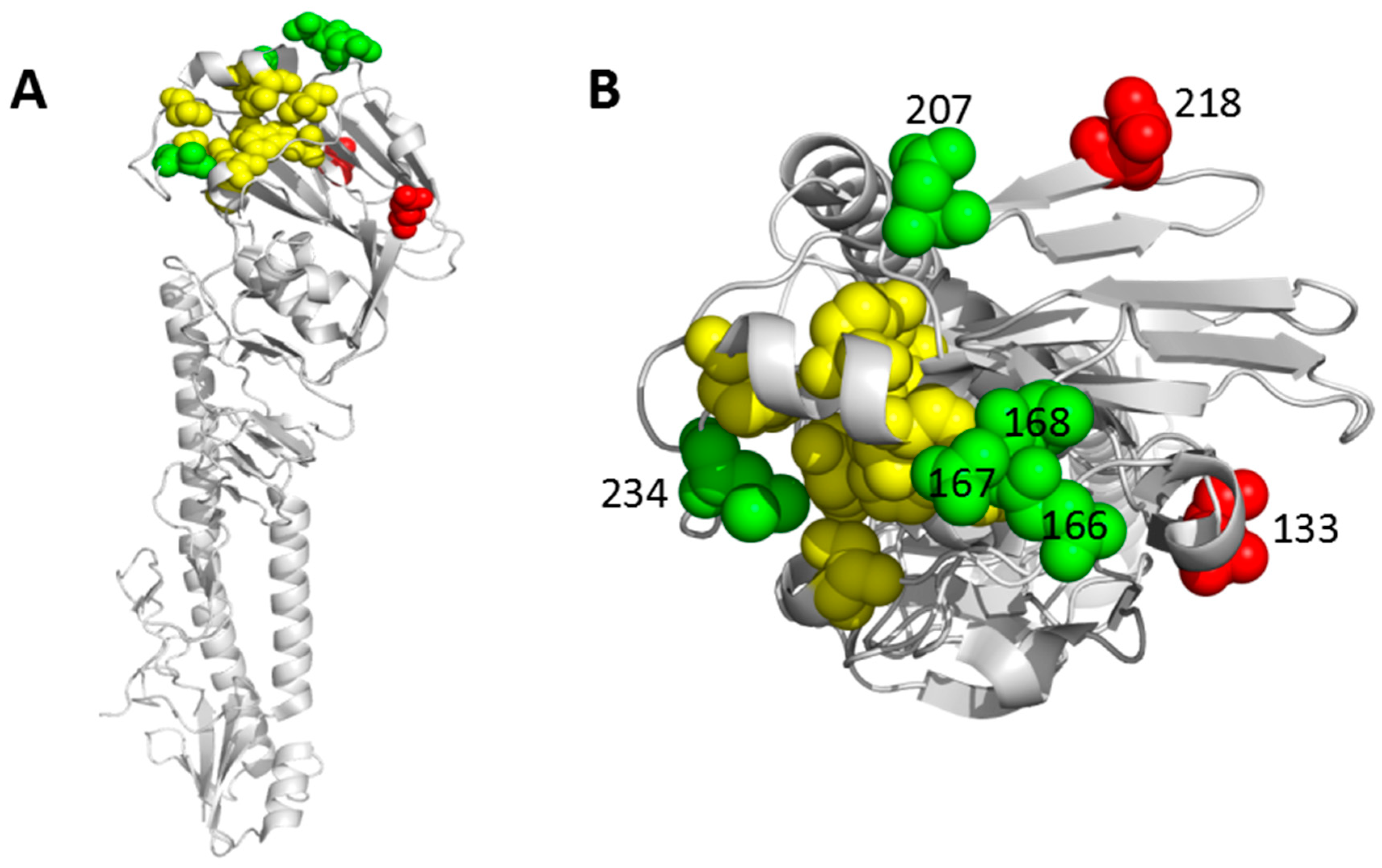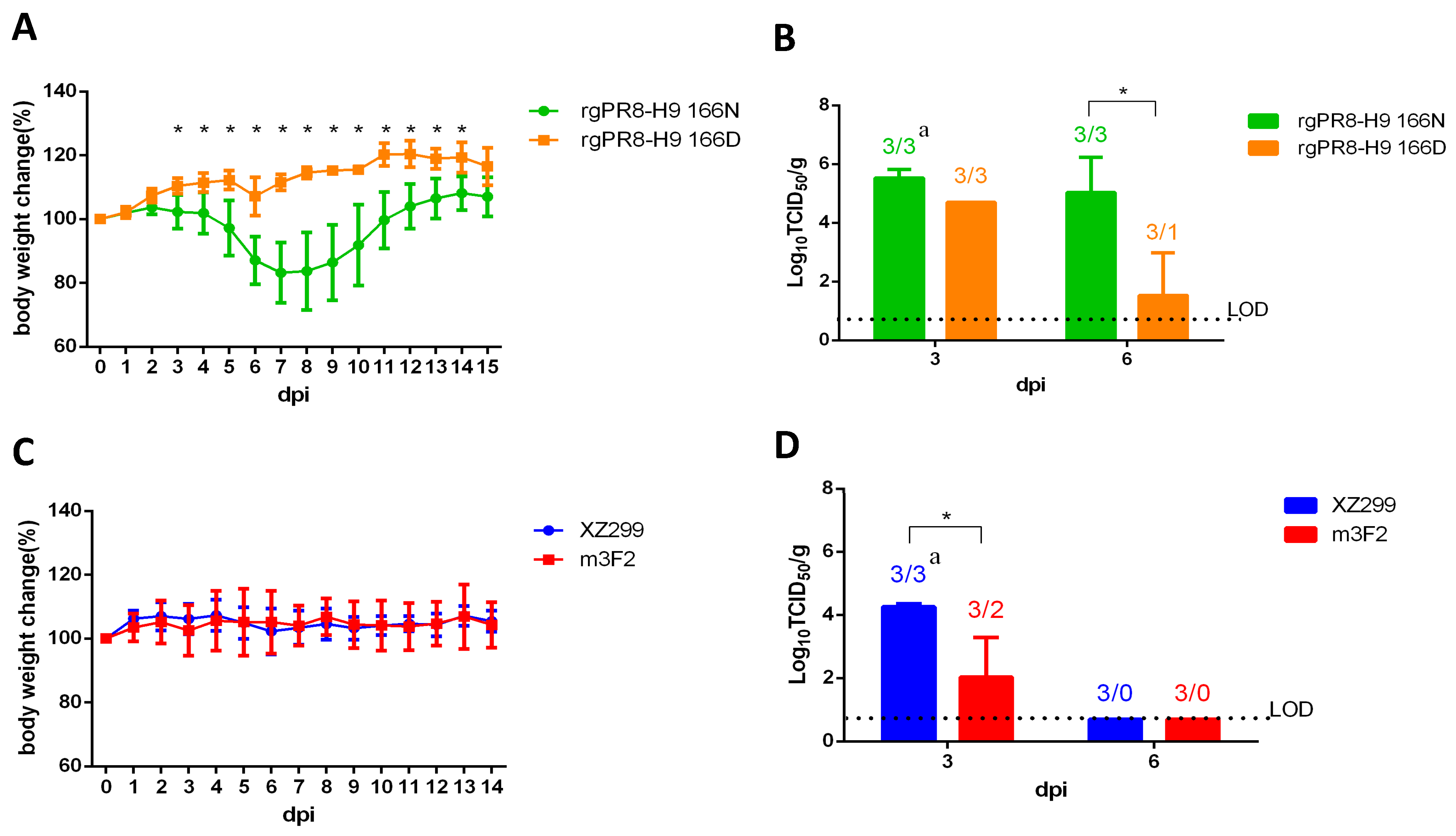A Single Mutation N166D in Hemagglutinin Affects Antigenicity and Pathogenesis of H9N2 Avian Influenza Virus
Abstract
1. Introduction
2. Materials and Methods
2.1. Virus and Cells
2.2. Monoclonal Antibodies (MAbs)
2.3. HI (Hemagglutination Inhibition) Assay
2.4. Selection of Escape Mutant
2.5. Recombinant Viruses Rescused by Reverse Genetics
2.6. Viral Growth Kinetics
2.7. Mice Study
2.8. Chicken Study
2.9. Statistical Analysis
2.10. Ethics Statement
3. Results
3.1. Four Immune Escape Mutants were Generated by Three MAbs against H9N2
3.2. Seven Critical Sites Associated with Antigenecity were Identified in HA of H9N2
3.3. Single N166D Mutation Did not Affect the Viral Replication in MDCK Cells
3.4. Single N166D Mutation Attenuated the Pathogenesis H9N2 in Mice
3.5. Single N166D Mutation Resulted in Low HI Reaction for Chicken Sera
4. Discussion
Author Contributions
Funding
Conflicts of Interest
References
- Kim, J.A.; Cho, S.H.; Kim, H.S.; Seo, S.H. H9N2 influenza viruses isolated from poultry in Korean live bird markets continuously evolve and cause the severe clinical signs in layers. Vet. Microbiol. 2006, 118, 169–176. [Google Scholar] [CrossRef] [PubMed]
- Jakhesara, S.J.; Bhatt, V.D.; Patel, N.V.; Prajapati, K.S.; Joshi, C.G. Isolation and characterization of H9N2 influenza virus isolates from poultry respiratory disease outbreak. Springerplus 2014, 3, 196. [Google Scholar] [CrossRef] [PubMed]
- Pu, J.; Wang, S.; Yin, Y.; Zhang, G.; Carter, R.A.; Wang, J.; Xu, G.; Sun, H.; Wang, M.; Wen, C.; et al. Evolution of the H9N2 influenza genotype that facilitated the genesis of the novel H7N9 virus. Proc. Natl. Acad. Sci. USA 2015, 112, 548–553. [Google Scholar] [CrossRef] [PubMed]
- Gu, M.; Chen, H.; Li, Q.; Huang, J.; Zhao, M.; Gu, X.; Jiang, K.; Wang, X.; Peng, D.; Liu, X. Enzootic genotype S of H9N2 avian influenza viruses donates internal genes to emerging zoonotic influenza viruses in China. Vet. Microbiol. 2014, 174, 309–315. [Google Scholar] [CrossRef] [PubMed]
- Deng, G.; Shi, J.; Wang, J.; Kong, H.; Cui, P.; Zhang, F.; Tan, D.; Suzuki, Y.; Liu, L.; Jiang, Y.; et al. Genetics, Receptor Binding, and Virulence in Mice of H10N8 Influenza Viruses Isolated from Ducks and Chickens in Live Poultry Markets in China. J. Virol. 2015, 89, 65066–65510. [Google Scholar] [CrossRef] [PubMed]
- Guan, Y.; Shortridge, K.F.; Krauss, S.; Chin, P.S.; Dyrting, K.C.; Ellis, T.M.; Webster, R.G.; Peiris, M. H9N2 influenza viruses possessing H5N1-like internal genomes continue to circulate in poultry in southeastern China. J. Virol. 2000, 74, 9372–9380. [Google Scholar] [CrossRef] [PubMed]
- Wu, A.; Su, C.; Wang, D.; Peng, Y.; Liu, M.; Hua, S.; Li, T.; Gao, G.F.; Tang, H.; Chen, J.; et al. Sequential reassortments underlie diverse influenza H7N9 genotypes in China. Cell Host Microbe. 2013, 14, 446–452. [Google Scholar] [CrossRef] [PubMed]
- Park, K.J.; Kwon, H.I.; Song, M.S.; Pascua, P.N.; Baek, Y.H.; Lee, J.H.; Jang, H.L.; Lim, J.Y.; Mo, I.P.; Moon, H.J.; et al. Rapid evolution of low-pathogenic H9N2 avian influenza viruses following poultry vaccination programmes. J. Gen. Virol. 2011, 92, 36–50. [Google Scholar] [CrossRef] [PubMed]
- Sun, Y.; Pu, J.; Fan, L.; Sun, H.; Wang, J.; Zhang, Y.; Liu, L.; Liu, J. Evaluation of the protective efficacy of a commercial vaccine against different antigenic groups of H9N2 influenza viruses in chickens. Vet. Microbiol. 2012, 156, 1931–1999. [Google Scholar] [CrossRef] [PubMed]
- Banet-Noach, C.; Perk, S.; Simanov, L.; Grebenyuk, N.; Rozenblut, E.; Pokamunski, S.; Pirak, M.; Tendler, Y.; Panshin, A. H9N2 influenza viruses from Israeli poultry: A five-year outbreak. Avian. Dis. 2007, 51, 2902–2996. [Google Scholar] [CrossRef] [PubMed]
- Zhang, P.; Tang, Y.; Liu, X.; Peng, D.; Liu, W.; Liu, H.; Lu, S.; Liu, X. Characterization of H9N2 influenza viruses isolated from vaccinated flocks in an integrated broiler chicken operation in eastern China during a 5 year period (1998–2002). J. Gen. Virol. 2008, 89, 31023–31112. [Google Scholar] [CrossRef] [PubMed]
- Bush, R.M.; Bender, C.A.; Subbarao, K.; Cox, N.J.; Fitch, W.M. Predicting the Evolution of Human Influenza A. Science 1999, 286, 19211–19925. [Google Scholar] [CrossRef] [PubMed]
- Zhu, Y.; Yang, D.; Ren, Q.; Yang, Y.; Liu, X.; Xu, X.; Liu, W.; Chen, S.; Peng, D.; Liu, X. Identification and characterization of a novel antigenic epitope in the hemagglutinin of the escape mutants of H9N2 avian influenza viruses. Vet. Microbiol. 2015, 178, 1441–1449. [Google Scholar] [CrossRef] [PubMed]
- Wan, Z.; Ye, J.; Xu, L.; Shao, H.; Jin, W.; Qian, K.; Wan, H.; Qin, A. Antigenic mapping of the hemagglutinin of an H9N2 avian influenza virus reveals novel critical amino acid positions in antigenic sites. J. Virol. 2014, 88, 3898–3901. [Google Scholar] [CrossRef] [PubMed]
- Kaverin, N.V.; Rudneva, I.A.; Ilyushina, N.A.; Lipatov, A.S.; Krauss, S.; Webster, R.G. Structural differences among hemagglutinins of influenza A virus subtypes are reflected in their antigenic architecture: Analysis of H9 escape mutants. J. Virol. 2004, 78, 2402–2449. [Google Scholar] [CrossRef] [PubMed]
- Ping, J.; Li, C.; Deng, G.; Jiang, Y.; Tian, G.; Zhang, S.; Bu, Z.; Chen, H. Single-amino-acid mutation in the HA alters the recognition of H9N2 influenza virus by a monoclonal antibody. Biochem. Biophys. Res. Commun. 2008, 371, 168–171. [Google Scholar] [CrossRef] [PubMed]
- Peacock, T.; Reddy, K.; James, J.; Adamiak, B.; Barclay, W.; Shelton, H.; Iqbal, M. Antigenic mapping of an H9N2 avian influenza virus reveals two discrete antigenic sites and a novel mechanism of immune escape. Sci. Rep. 2016, 6, 18745. [Google Scholar] [CrossRef] [PubMed]
- Okamatsu, M.; Sakoda, Y.; Kishida, N.; Isoda, N.; Kida, H. Antigenic structure of the hemagglutinin of H9N2 influenza viruses. Arch. Virol. 2008, 153, 2189–2195. [Google Scholar] [CrossRef] [PubMed]
- Kohler, G.; Milstein, C. Derivation of specific antibody-producing tissue culture and tumor lines by cell fusion. Eur. J. Immunol. 1976, 6, 5115–5119. [Google Scholar] [CrossRef] [PubMed]
- Lee, M.S.; Chang, P.C.; Shien, J.H.; Cheng, M.C.; Shieh, H.K. Identification and subtyping of avian influenza viruses by reverse transcription-PCR. J. Virol. Methods 2001, 97, 13–22. [Google Scholar] [CrossRef]
- Gerhard, W.; Webster, R.G. Antigenic drift in influenza A viruses. I. Selection and characterization of antigenic variants of A/PR/8/34 (HON1) influenza virus with monoclonal antibodies. J. Exp. Med. 1978, 148, 3833–3892. [Google Scholar] [CrossRef] [PubMed]
- Jianqiang, Y.; Sorrell, E.M.; Yibin, C.; Hongxia, S.; Kemin, X.; Lindomar, P.; Danielle, H.; Haichen, S.; Matthew, A.; Medina, R.A. Variations in the hemagglutinin of the 2009 H1N1 pandemic virus: Potential for strains with altered virulence phenotype? Plos Pathogens. 2010, 6, e1001145. [Google Scholar]
- Shao, H.; Fan, Z.; Wan, Z.; Tian, X.; Chen, H.; Perez, D.R.; Qin, A.; Ye, J. An efficient and rapid influenza gene cloning strategy for reverse genetics system. J. Virol. Methods 2015, 222, 91–94. [Google Scholar] [CrossRef] [PubMed]
- Ha, Y.; Stevens, D.J.; Skehel, J.J.; Wiley, D.C. X-ray structures of H5 avian and H9 swine influenza virus hemagglutinins bound to avian and human receptor analogs. Proc. Natl. Acad. Sci. USA 2001, 98, 11181–11186. [Google Scholar] [CrossRef] [PubMed]




| MAb | HI Titers (log2) a | Mutations | ||||
|---|---|---|---|---|---|---|
| XZ299 | Mutants | m3F2 | rgPR8-H9 166N | rgPR8-H9 166D | ||
| 2G10 | 10 | 3 (m2G10-1) | 4 | 9 | 1 | Q133L/D207N/N218D/L234M b |
| - (m2G10-2) | Q133L/A168D/D207N/N218D | |||||
| 3F2 | 7 | 1 (m3F2) | 1 | 10 | - | N166D |
| 5C7 | 10 | 5 (m5C7) | 10 | / c | / | Q133L/N167K/D207N/N218D |
© 2019 by the authors. Licensee MDPI, Basel, Switzerland. This article is an open access article distributed under the terms and conditions of the Creative Commons Attribution (CC BY) license (http://creativecommons.org/licenses/by/4.0/).
Share and Cite
Jin, F.; Dong, X.; Wan, Z.; Ren, D.; Liu, M.; Geng, T.; Zhang, J.; Gao, W.; Shao, H.; Qin, A.; et al. A Single Mutation N166D in Hemagglutinin Affects Antigenicity and Pathogenesis of H9N2 Avian Influenza Virus. Viruses 2019, 11, 709. https://doi.org/10.3390/v11080709
Jin F, Dong X, Wan Z, Ren D, Liu M, Geng T, Zhang J, Gao W, Shao H, Qin A, et al. A Single Mutation N166D in Hemagglutinin Affects Antigenicity and Pathogenesis of H9N2 Avian Influenza Virus. Viruses. 2019; 11(8):709. https://doi.org/10.3390/v11080709
Chicago/Turabian StyleJin, Fang, Xiaomei Dong, Zhimin Wan, Dan Ren, Min Liu, Tuoyu Geng, Jianjun Zhang, Wei Gao, Hongxia Shao, Aijian Qin, and et al. 2019. "A Single Mutation N166D in Hemagglutinin Affects Antigenicity and Pathogenesis of H9N2 Avian Influenza Virus" Viruses 11, no. 8: 709. https://doi.org/10.3390/v11080709
APA StyleJin, F., Dong, X., Wan, Z., Ren, D., Liu, M., Geng, T., Zhang, J., Gao, W., Shao, H., Qin, A., & Ye, J. (2019). A Single Mutation N166D in Hemagglutinin Affects Antigenicity and Pathogenesis of H9N2 Avian Influenza Virus. Viruses, 11(8), 709. https://doi.org/10.3390/v11080709




